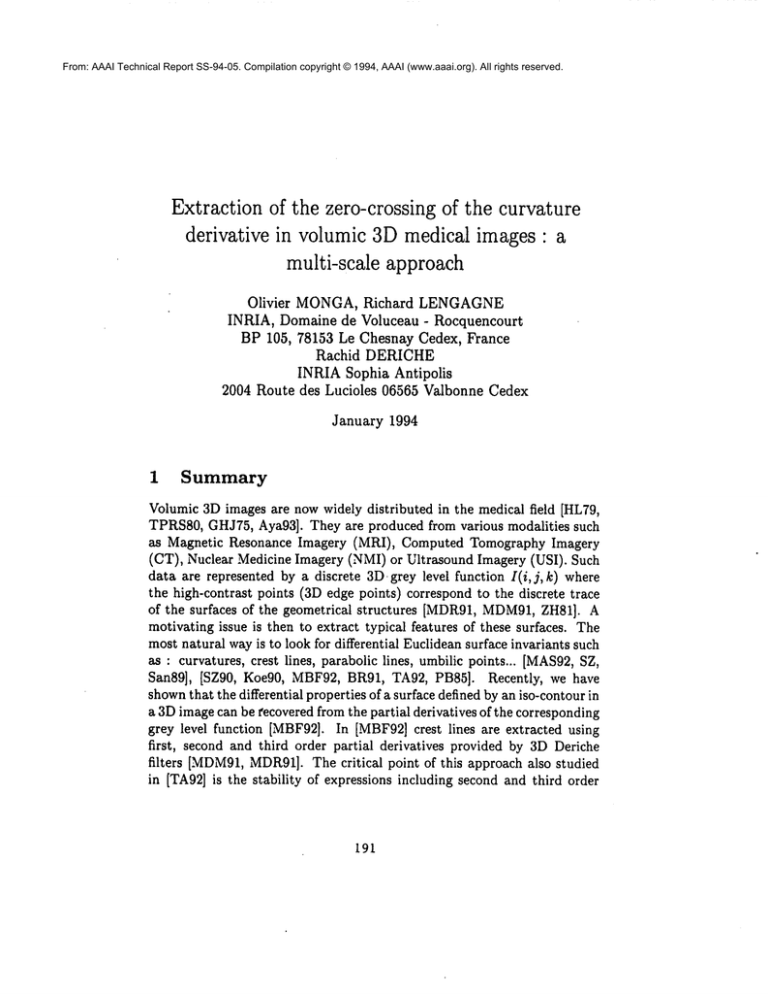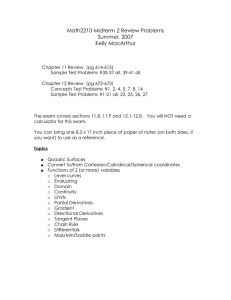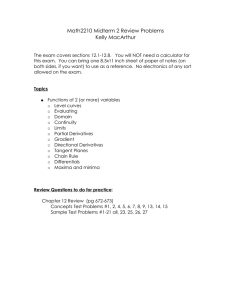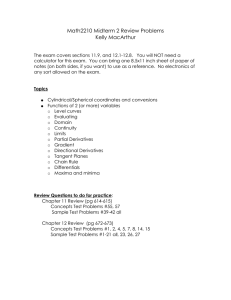
From: AAAI Technical Report SS-94-05. Compilation copyright © 1994, AAAI (www.aaai.org). All rights reserved.
Extraction of the zero-crossing of the curvature
derivative in volumic 3D medical images" a
multi-scale approach
Olivier
MONGA, Richard
LENGAGNE
INRIA, Domaine de Voluceau - Rocquencourt
BP 105, 78153 Le Chesnay Cedex, France
Rachid DERICHE
INRIA Sophia Antipolis
2004 Route des Lucioles 06565 Valbonne Cedex
January
1
1994
Summary
Volumic 3D images are now widely distributed in the medical field [HL79,
TPRSS0, GHJ75, Aya93]. They are produced from various modalities such
as Magnetic Resonance Imagery (MRI), Computed Tomography Imagery
(CT), Nuclear Medicine Imagery (NMI) or Ultrasound Imagery (USI).
data are represented by a discrete 3D grey level function I(i,j, k) where
the high-contrast points (3D edge points) correspond to the discrete trace
of the surfaces of the geometrical structures [MDR91,MDMgl,ZHS1]. A
motivating issue is then to extract typical features of these surfaces. The
most natural wayis to look for differential Euclidean surface invariants such
as : curvatures, crest lines, parabolic lines, umbilic points... [MAS92,SZ,
San89], [SZ90, Koe90, MBF92, BR91, TA92, PB85]. Recently, we have
shownthat the differential properties of a surface defined by an iso-contour in
a 3D image can be t’ecovered from the partial derivatives of the corresponding
grey level function [MBF92]. In [MBF92]crest lines are extracted using
first, second and third order partial derivatives provided by 3D Deriche
filters [MDM91,MDR91].The critical point of this approach also studied
in [TA92] is the stability of expressions including second and third order
191
partial derivatives such as the "extremality criterion" defined in [MBF92,
TA92].
In this work we propose recursive 3D filters to improve the computation
of partial derivatives and also a multi-scale approach to extract the zerocrossings of the extremality criterion.
First, we showthat derivative filters comingfrom isotropic (rotation invariant) smoothing filters should be used to ensure the Euclidean invariance
of the curvatures. Then we derive an algorithm to computefirst, second and
third order partial derivatives of a 3D volumic image. These derivatives are
used to obtain curvatures invariant by rigid motion (Euclidean invariant).
Then we deal with the computation of the curvatures of the surfaces
traced by the iso-contours (3D edge points) from the partial derivatives
the image (for instance provided by the previous method). Weuse the main
results of the reference [MBF92]and show the problems induced by a single
scale filtering.
Finally, we propose to use different widths of filters to compute the
curvatures. This leads to a multi-scale curvature computation scheme where
the scale is the width of the filters. Weapply this principle to track the
zero-crossings of the derivative of the maximumcurvature points along the
maximumcurvature direction (extremality criterion) which correspond
the crest points. The zero-crossings coming from the different scales are
merged using a valuated adjacency graph. We propose some simple and
efficient strategies to extract stable zero-crossings from this graph.
Wepresent experimental results obtained on synthe.tic and real data (CT
and MR3D images). We show that our approach combining a multi-scale
schemeand also the use of better filters provides reliable crest lines even for
noisy data.
This work is more precisely described in the reference [MLD94].
References
[Aya93]
Nicholas Ayache. Computer vision applied to 3d medical images : Results,
future challenges. INRIA Report research, September 1993.
[BR91]
J. Koenderink
B. Romeny,L. Florack.
Invariant
thirdorderproperties
of isophotes:
Tjunction detection. In Proc. 7th Scandina~ien Conference on Image Analysis, Aalbo~,
August 1991.
[GHJ75]
Richard Gordon, Gabor T. Herman, and Steven A. Johnson. Image reconstruction
from projections.
Scientific
American, 233(4):56-68, October 1975.
[HL79]
Gabor T. Herman and Hsun Kao Liu. Three-dimensionaldisplay of human organs
from computedtomograms.ComputerGraphicsand ImageProcessing,9:1-21,1979.
192
trends and
...,
..*.~J
°.’~s
.:.,,..~........ ."
’~ ....
. t,,.w
".."
..-"
- .~ "~
.,p,/...;,
I .; --.: "~
o ..:
¯ ..
¯ , .
° O°~o -. ~ ’ ..
¯ i_~,~
...~,~,~.
~..
-
%.
r
Figure 1: Up : perspective views corresponding to the positions A (left)
and B (right) wherethe grey level is set to the numberof scales such that
the point is a crest point ; middle : perspective views correspondingto the
positions A (left) and B (right) whereonly the points whichare crest points
for at least 4 scales are marked;bottom:perspective views correspondingto
the positions A (left) and B (right) whereonly the points which are crest
points for at least 5 scales are marked.
193
[Koe90]
JanJ. Koenderink.
SolidShape.
MITPress,
Boston,
1990.
[MAS92] O. Monga,N. Ayache, and P. Sander. Fromvoxel to intrinsic surface features. Image
and Vision Computing Volume I0, Number6, Aout 1992. a shortened version is in
IPMI’91, Lecture Notes in ComputerScience 511, Springer Verlag.
[MBF92] Olivier Monga,Serge Benayoun,and Olivier D. Faugeras. Using third order derivatives to extract ridge lines in 3d images. In IEEECo~z/erence on Vision and Pattern
Recognition, Urbana Champaign, June 1992.
[MDM91] Olivier Monga,Rachid Deriche, and Gregoire Malandain. Recursive filtering and edge
closing: two primary tools for 3d edge detection. Image and Vision Computing, Vol.
9, Number~, August 1991. A shortened version is in proc. of ECCV’90,Lecture notes
in ComputerScience 427.
[MDR91] Olivier Monga,Rachid Deriche, and Jean-Marie Rocchisani. 3d edge detection using
recursive filtering: Application to scanner images. ComputerVision Graphic and
Image Processing, Vol. 53, No 1, pp. 76-87, January 1991.
[MLD94] Olivier Monga,Richard Lengagne,and Rachid Deriche. Extraction of the zero-crossing
of the curvature derivative in volumic 3d medical images : a multi-scale approach.
INRIAReport research, 1994.
[PB85]
Jean Ponceand Michael Brady. Towarda surface primal sketch. In Proceedings, IJCAI,
1985.
[SanS9]
Peter T. Sander. Generic curvature features from 3-D images. IEEE Transactions on
Systems, Man, and Cybernetics, 19(6):1623-1635, November1989.
[sz]
Peter T. Sander and Steven W.Zucker. Singularities of principal direction fields from
3-D images. IEEE T~’ansactions on Pattern Analyaia and Machine Intelligence. To
appear. Available as Technical Report CIM-88-7,McGillResearchCenter for Intelligent
Machines, McGill University, Montr~ai.
[sz9o]
Peter
T.Sander
andSteven
W:Zucker.
Inferring
surface
trace
anddifferential
structure
from 3-D images. IEEE 2~’ansactions on Pattern Analysis and MachineIntelligence,
12(9), September 1990.
[TA92]
J-P. Thirion and GourdonA. The 3d marching lines algorithm and its application to
crest lines extraction. Technical Report 1672, INRIA,May1992.
[TPRS80] Micheai
M. Ter-Pogossian,
Marcus
E.Raichle,
andBurton
E. Sobel.
Positron-emmision
tomography.
Scientific
American,
243(4):170-181,
October
1980.
[ZH81]
S.W. Zucker and R.M. Hummel.A three-dimensional edge operator. IEEE Transactions on Pattern Analysis and Machine Intelligence, PAMI-3(3):324-331, May1981.
194





